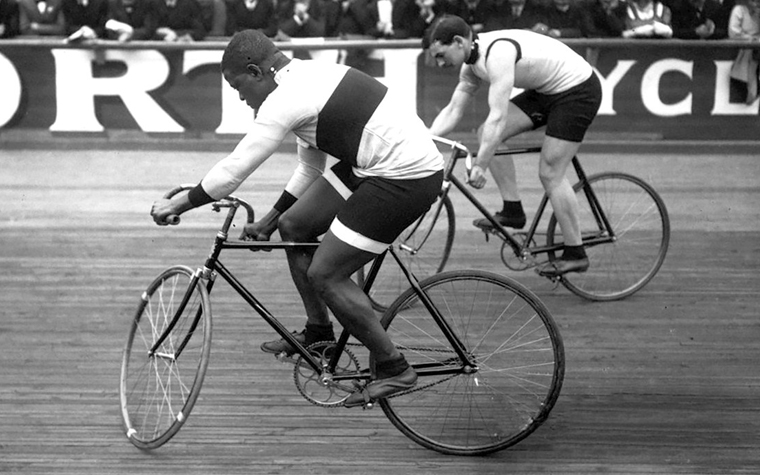The Remarkable Journey of Marshall “Major” Taylor: A Pioneering Cyclist
Marshall Walter “Major” Taylor, born on November 26, 1878, in Indianapolis, Indiana, was a trailblazing cyclist who broke barriers and achieved extraordinary success in the face of intense adversity. From his humble beginnings to becoming one of the most celebrated athletes of his time, Taylor’s life is a testament to resilience, talent, and determination. Taylor grew up in modest circumstances. His father, Gilbert Taylor, a Civil War veteran and farmer, worked as a carriage driver for a wealthy white family in Indianapolis. Young Marshall often accompanied his father to work, where he formed a close bond with the employer’s son. This relationship led to Taylor moving in with the family, providing him with access to a stable home environment and better educational opportunities.
It was during these formative years that Taylor received a life-changing gift: a bicycle. The young boy quickly developed a passion for cycling, teaching himself tricks that delighted his friends and impressed onlookers. His talent caught the attention of a local bike shop owner, who hired him to perform stunts outside the shop to attract customers. Wearing a military-style uniform during his performances earned him the nickname “Major,” a moniker that stayed with him throughout his life. Encouraged by the bike shop owner, Taylor entered his first race as a teenager—a 10-mile event that he won with ease. By the age of 18, he had relocated to Worcester, Massachusetts, to pursue professional cycling. His first major competition was a grueling six-day race at Madison Square Garden in New York City, where he finished eighth. This marked the beginning of an illustrious career.









Taylor’s ascent in the cycling world was meteoric. By 1898, he held seven world records, and in 1899, he became both the national and international cycling champion. This achievement made him the second Black athlete to win a world championship title, following bantamweight boxer George Dixon. Taylor’s victories extended beyond the United States; he competed internationally, earning accolades in Australia, Europe, and across North America. Despite his remarkable achievements, Taylor faced relentless racism throughout his career. In the United States, particularly in the South, he was often barred from competing due to segregation laws. Even in regions where he was allowed to race, he endured hostility from competitors and spectators alike. Fellow cyclists frequently resorted to unsportsmanlike tactics, such as bumping or blocking him during races. Crowds hurled objects at him while he rode.
One particularly harrowing incident occurred during a race in Boston when competitor W.E. Becker shoved Taylor off his bike and choked him until police intervened. Taylor was left unconscious for 15 minutes. Such incidents were not uncommon but failed to deter him from pursuing his passion. Europe offered some respite from the overt racism he faced in America. There, Black athletes were generally more accepted, allowing Taylor to focus on his craft without constant harassment. Nevertheless, the physical and emotional toll of his grueling racing schedule and persistent discrimination weighed heavily on him.
At the age of 32, Taylor retired from professional cycling. Despite the challenges he faced, he had become one of the wealthiest athletes of his era—an extraordinary feat for a Black man in the early 20th century. However, his post-racing life proved difficult. Business ventures failed, and he lost much of his earnings. Estranged from his wife and daughter, Taylor moved to Chicago in 1930. In Chicago, he lived at a YMCA and attempted to make ends meet by selling copies of his self-published autobiography, *The Fastest Bicycle Rider in the World.* Unfortunately, these efforts were not enough to sustain him. On June 21, 1932, Taylor passed away penniless in the charity ward of a Chicago hospital at the age of 53.
Initially buried in an unmarked grave in the welfare section of Mount Glenwood Cemetery in Cook County, Illinois, Taylor’s legacy was later honored by a group of former professional cyclists and Frank Schwinn, owner of Schwinn Bicycle Company. In 1948, they arranged for his body to be exhumed and reburied in a more prominent location. Marshall “Major” Taylor’s story is one of triumph over adversity. He not only broke records but also shattered racial barriers during an era when prejudice was deeply entrenched in society. His courage and determination paved the way for future generations of Black athletes.
Today, Taylor is remembered as a pioneer who fought against overwhelming odds to achieve greatness. His legacy continues to inspire athletes and advocates for racial equality worldwide.

